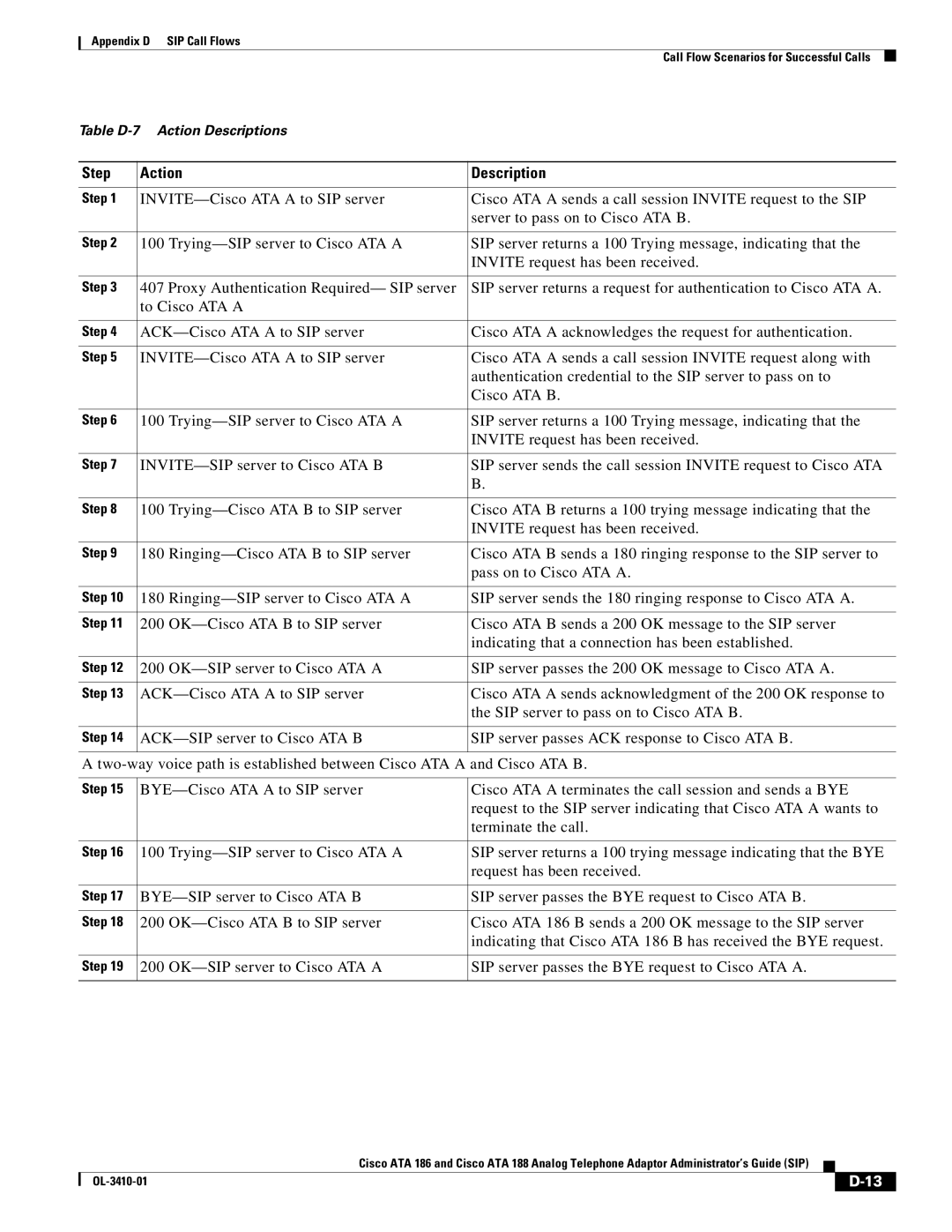
Appendix D SIP Call Flows
Call Flow Scenarios for Successful Calls
Table D-7 Action Descriptions
Step | Action | Description | |
|
|
| |
Step 1 | Cisco ATA A sends a call session INVITE request to the SIP | ||
|
|
| server to pass on to Cisco ATA B. |
|
|
|
|
Step 2 | 100 | SIP server returns a 100 Trying message, indicating that the | |
|
|
| INVITE request has been received. |
|
|
| |
Step 3 | 407 Proxy Authentication Required— SIP server | SIP server returns a request for authentication to Cisco ATA A. | |
| to Cisco ATA A |
| |
|
|
| |
Step 4 | Cisco ATA A acknowledges the request for authentication. | ||
|
|
| |
Step 5 | Cisco ATA A sends a call session INVITE request along with | ||
|
|
| authentication credential to the SIP server to pass on to |
|
|
| Cisco ATA B. |
|
|
|
|
Step 6 | 100 | SIP server returns a 100 Trying message, indicating that the | |
|
|
| INVITE request has been received. |
|
|
| |
Step 7 | SIP server sends the call session INVITE request to Cisco ATA | ||
|
|
| B. |
|
|
|
|
Step 8 | 100 | Cisco ATA B returns a 100 trying message indicating that the | |
|
|
| INVITE request has been received. |
|
|
|
|
Step 9 | 180 | Cisco ATA B sends a 180 ringing response to the SIP server to | |
|
|
| pass on to Cisco ATA A. |
|
|
|
|
Step 10 | 180 | SIP server sends the 180 ringing response to Cisco ATA A. | |
|
|
|
|
Step 11 | 200 | Cisco ATA B sends a 200 OK message to the SIP server | |
|
|
| indicating that a connection has been established. |
|
|
|
|
Step 12 | 200 | SIP server passes the 200 OK message to Cisco ATA A. | |
|
|
| |
Step 13 | Cisco ATA A sends acknowledgment of the 200 OK response to | ||
|
|
| the SIP server to pass on to Cisco ATA B. |
|
|
| |
Step 14 | SIP server passes ACK response to Cisco ATA B. | ||
|
|
| |
A | |||
|
|
| |
Step 15 | Cisco ATA A terminates the call session and sends a BYE | ||
|
|
| request to the SIP server indicating that Cisco ATA A wants to |
|
|
| terminate the call. |
|
|
|
|
Step 16 | 100 | SIP server returns a 100 trying message indicating that the BYE | |
|
|
| request has been received. |
|
|
| |
Step 17 | SIP server passes the BYE request to Cisco ATA B. | ||
|
|
|
|
Step 18 | 200 | Cisco ATA 186 B sends a 200 OK message to the SIP server | |
|
|
| indicating that Cisco ATA 186 B has received the BYE request. |
|
|
|
|
Step 19 | 200 | SIP server passes the BYE request to Cisco ATA A. | |
|
|
|
|
Cisco ATA 186 and Cisco ATA 188 Analog Telephone Adaptor Administrator’s Guide (SIP)
| ||
|
